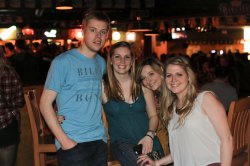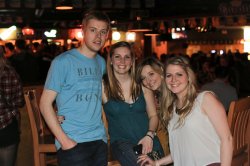So i upgraded to a canon 70D DSLR, still getting use to it. I wouldnt say im a noob with photography as I know a few things about playing with aperture, depth of field and the basics....
Anyways I shot this photo of a group of people and the other photos were of similar to this.
The equipment was a Canon 70D with a Canon 1.4 35mm L lens.
The settings were:
ISO - 1600
35mm
O EV
f/2.8
shutter: 1/60.
flash (the built in flash)
the setting was, bar/club kind of scene with dim lighting is best i could describe it.
was there anything i could have done with what I had to make it better in terms of settings or what would you guys have set the camera to if you were in my position?
I won't lie I set the camera on auto. I'm getting more inclined to go manual but I would hate to ruin a photo of good friends so I'm still more confident in the cameras settings then my own but hopefully in time I will get more use to manual, hence why I am asking here right now.
Also my last request was. does anyone here have alot of post processing skills to make this pic better? I just want atleast one to look nice in the album
Full sized picture on flikr:
https://www.flickr.com/photos/24140175@N02/13477153053/
Anyways I shot this photo of a group of people and the other photos were of similar to this.
The equipment was a Canon 70D with a Canon 1.4 35mm L lens.
The settings were:
ISO - 1600
35mm
O EV
f/2.8
shutter: 1/60.
flash (the built in flash)
the setting was, bar/club kind of scene with dim lighting is best i could describe it.
was there anything i could have done with what I had to make it better in terms of settings or what would you guys have set the camera to if you were in my position?
I won't lie I set the camera on auto. I'm getting more inclined to go manual but I would hate to ruin a photo of good friends so I'm still more confident in the cameras settings then my own but hopefully in time I will get more use to manual, hence why I am asking here right now.
Also my last request was. does anyone here have alot of post processing skills to make this pic better? I just want atleast one to look nice in the album
Full sized picture on flikr:
https://www.flickr.com/photos/24140175@N02/13477153053/






